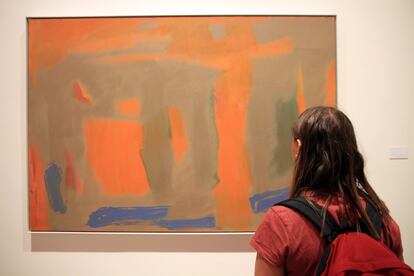When Claude Monet (1840-1926) was in his last years of life, he confessed that he had become an artist thanks to flowers.
A devoted gardener and horticulturist, the landscape paintings of the great Impressionist pope are an example of experimentation that would later serve as inspiration for the other Impressionists, the Post-Impressionists and the avant-garde women of the early 20th century.
Paul Klee, Emil Nolde, Gustav Klimt, Vassily Kandinsky or Henri Matisse literally entered wild or perfectly outlined gardens.
More information
An exhibition covers the look of artists on Segovia
In Spain there was a small but spectacular list of names that amazed the world on both sides of the Atlantic.
They were Joaquín Sorolla, Esteban Vicente, Joaquín Mir and Santiago Rusiñol.
The first two, Sorolla and Vicente, an impressionist and an abstract expressionist, star
In the light of the garden
, one of the great exhibitions of the summer, in which it can be seen how two artists who never met shared the same way of unraveling light among the greenery of their particular landscapes.
The exhibition opens to the public this Friday at the Esteban Vicente Museum of Contemporary Art in Segovia, with free admission, and will remain open until October 2.
In New York, the city where Vicente achieved international recognition and success, a similar exhibition will be held at the Parrish Art Museum from August 7 to October 16.
The curator of the exhibition, Ana Doldán, during the presentation of the exhibition 'In the light of the garden'. VICENTE TANARRO
The curator director of the Segovian museum, Ana Doldán de Cáceres, is also the curator of an exhibition designed in 2019, but which, like so many things, was postponed due to the pandemic.
She assures that nothing has diminished the original project and the 80 works that hang in the rooms put together an exhibition concept that describes how both, with different forms of expression, investigated the same settings (the gardens) to extract light with the to challenge time.
The bulk of the paintings come from the museum itself, repository of the legacy of the artist who, due to his republican activity, left Spain in 1939. Installed in New York, he obtained US nationality in 1940.
The museum has completed the speech with numerous loans from public and private collections and has had the special collaboration of the Sorolla Museum, in Madrid,
Although many painters enjoyed experimenting in their own gardens, not all of them scratched their hands pulling weeds or opening holes to deposit seeds.
It is said of Monet that he knew everything about gardening and that his instructions were followed by no less than six gardeners.
Sorolla, very successful and busy, bought in 1905 the plot of land on Paseo del General Martínez Campos in Madrid where he built his house, his studio and a spectacular garden that was created following his strict instructions.
Due to his multiple trips, he often sent written instructions to his wife, Clotilde García del Castillo, also a devoted lover of a garden divided into three spaces and with an Andalusian patio in the neo-Spanish style.
Sorolla's paintings that accompany those of Esteban Vicente were painted during the last period of his life.
“Sorolla made the garden”, affirms the curator, “a work of art in itself.
Art and Nature merge in her particular paradise, a place of inspiration that she began to plant in 1911 and that since 1916 she has not stopped painting.
Both as a single and main theme or as a stage before which her portrayed characters posed”.
The seven canvases exhibited here are dated between 1916 and 1919.
A visitor contemplates one of Esteban Vicente's paintings in the exhibition. Vicente Tanarro
Roses, lilies, wallflowers, callas, oleanders and geraniums of all colors appear in his oil paintings, recognizable among large masses of color or as protagonists in the form of lilac, lily or pansy.
"He is interested in color, light and atmosphere," says Doldán.
“There is a certain path towards abstraction.
They are pictures made in a single session.
Sitting in the garden, forced by illness, he would sometimes finish the job in less than two hours”.
When Sorolla died in 1923, Esteban Vicente was 20 years old and had left his native Turégano (Segovia).
In Paris he connected with the European avant-gardes and with Matisse.
After the war, when he collaborates painting camouflage for the Republicans, he ends up settling in the United States and fully returning to painting.
Vicente's passion for gardens came from a very young age.
The success obtained from him by harvesting canary grass in a pot, led him to embark on the cultivation of roses.
Among the most gratifying memories of his life, he pointed out how he saw a rose planted by him grow and discover the thorns on his leaves.
From then on, as soon as he had some land, he would dig a hole and plant the plants from it.
His great landscape work came when he was able to create his own garden.
It happened in 1961, at the hands of his third wife, Harriet Godfried, with whom he bought a colonial-style farm and 8,000 square meters in Bridgehampton, on Long Island.
The curator says that this garden became a field of color “because nature was an indispensable source for Vicente, a sensory experience that he rescued in his paintings to give his paintings a sense of calm and mystical harmony.
The artist's gaze focuses on the garden, on masses of color resulting from the infinity of plants that he planted in the same space of the same tone.
They are fields of yellow, white, mauve or fuchsia that he transfers to his paintings”.
Doldán remembers that Vicente did not paint outdoors like the Impressionists.
He did it in the barn he used as a studio, alternating the color spray gun and sometimes the brushes.
The garden was cared for and pampered down to the smallest details until the last moment.
Upon his death, on January 10, 2001, shortly before his 98th birthday, the care was left in the hands of his wife.
Upon her death, both made one last trip to the garden of her Segovian museum, where her remains rest.
Around a monolith flowers are crowded that want to resurrect what was the garden of Bridgehampton.















